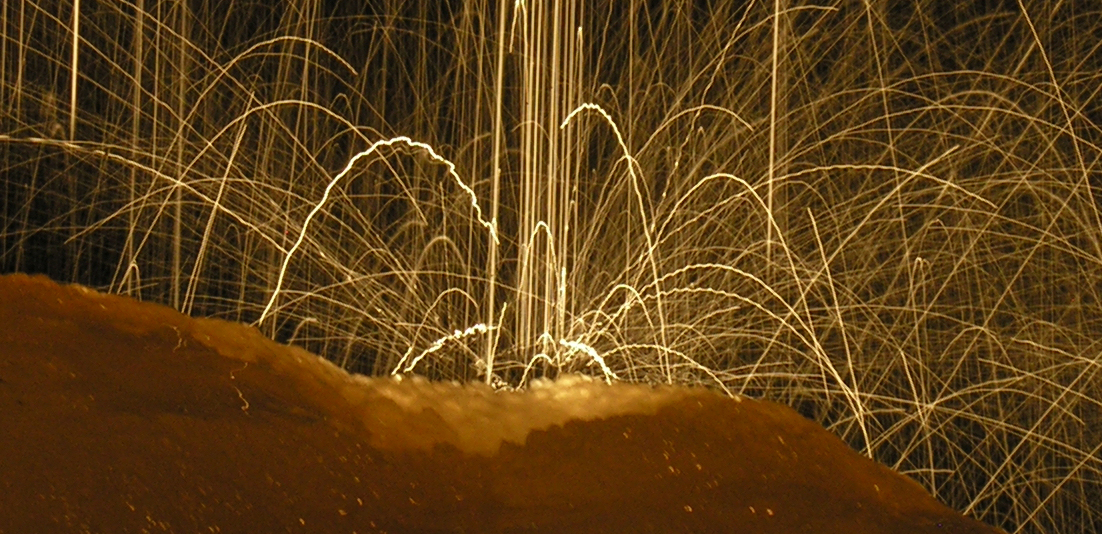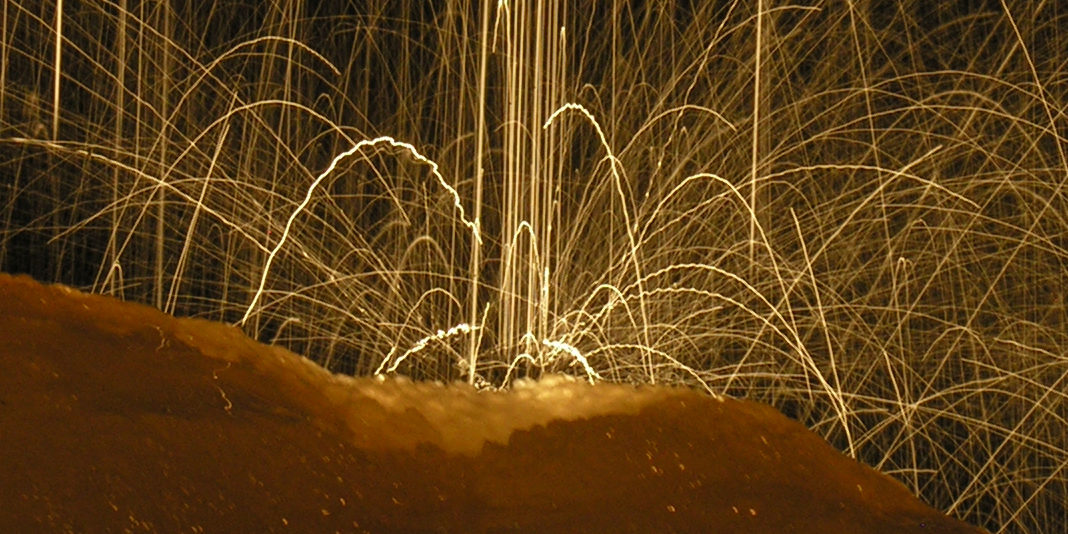Queste immagini non si riferiscono alle fontane di fuoco di un’eruzione vulcanica. Si tratta semplicemente di gocce d’acqua che cadono su una stalagmite, provocando una miriade di spruzzi che, in controluce, sembrano fuochi d’artificio.
La stalagmite in questione si trova nella Grotta del Vento, poco prima del Valico, lo spartiacque sotterraneo che che separa il primo dal secondo itinerario. Nel punto d’impatto delle gocce appare forata, poiché tra una goccia e l’altra non esiste un intervallo di tempo sufficiente da permettere il rilascio del carbonato di calcio, che viene comunque deposto dagli spruzzi tutto attorno, provocando la crescita complessiva della stalagmite (*).

La profondità del foro, che dipende dall’energia cinetica delle gocce, resta sempre la stessa, poiché il fondo si innalza alla stessa velocità della massa stalagmitica che lo circonda. È interessante osservare come la traiettoria degli spruzzi non sia sempre lineare.
Non tutte le stalagmiti sottoposte a uno stillicidio così intenso sono forate: nella Sala del Ciondolo, ad esempio, presentano anche nel punto d’impatto una superficie liscia.

Stalagmiti ogivali nella Sala del Ciondolo
Lo stillicidio intenso dà sempre luogo alla formazione di stalagmiti massicce di forma ogivale; le stalagmiti “a candela”, alte e slanciate, hanno invece origine da uno sgocciolio lento, con lunghi intervalli tra una goccia e l’altra.

Stalagmiti a candela nella Grotta di Frasassi (AN)
(*) Perché il calcare presente nell’acqua possa depositarsi, è necessaria una fuga di anidride carbonica; solo in questo modo il bicarbonato di calcio può trasformarsi in carbonato di calcio (calcite), solido e cristallino, incrementando le dimensioni della stalagmite. Perché ciò possa avvenire è però necessario un sufficiente intervallo di tempo tra una goccia e l’altra. La stessa regola vale anche per quanto riguarda la crescita delle stalattiti.
These pictures do not refer to the fountains of fire of an eruption of a volcano. They are simply drops of water falling onto a stalagmite, caused by a multitude of splashes which, in front of the light, look like fireworks.
The stalagmite in question is in the Grotta del Vento, just before the pass, the underground watershed which separates the first from the second itinerary. In the part where the drop hits the stalagmite it appears to have a hole, since between one drop and another there is not an interval of time long enough to allow calcium carbonate to be released, which however gets deposited all around it by the splashes, causing the overall growth of the stalagmite (*).
The depth of the hole, which depends on the kinetic energy of the drops, always remains the same, since the bottom rises up at the same speed of the stalagmite that surrounds it. It is interesting to note how the trajectory of the splashes is not always linear.
Not all stalagmites exposed to such an intense dripping have holes in them: in the Pendant Room, for example, they have a smooth surface also where the drop hits them.
Intense dripping always gives way to the formation of massive stalagmites with an ogival shape; the “candle-like” stalagmites, tall and slender, originate from a slow dripping, with long intervals between one drop and another.
(*) For the lime in the water to deposit, a leak of carbon dioxide is necessary; only in this way can the calcium bicarbonate transform into calcium carbonate (calcite), solid and crystalline, increasing the dimensions of the stalagmite. For this to happen however there must be a sufficient interval of time between one drop and another. The same rule applies for the growth of stallactites.








